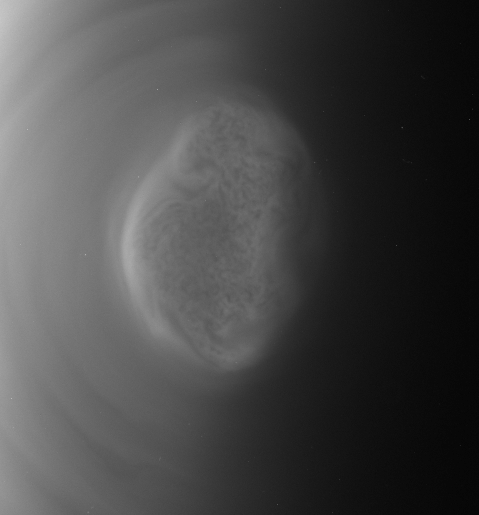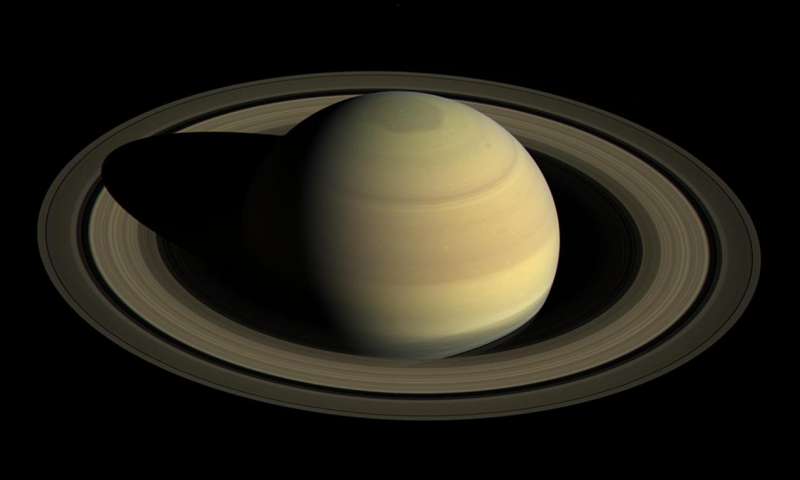
2017 EarthSky Lunar Calendar pre-sale…is happening NOW!
I’m nostalgic already about the Cassini spacecraft, which has been orbiting Saturn since 2004 and which is now in its final year. And it seems I’m not the only one. In a statement during last week’s joint meeting of the Division for Planetary Sciences and European Planetary Science Congress (October 16-21, 2016) – in Pasadena, California, space scientist Athena Coustenis of the Observatoire de Paris and her team also sounded nostalgic about Cassini and how it has let us track the changing seasons on Saturn’s largest moon, Titan. These scientists said:
Cassini has been the ideal platform for observing the pattern of seasonal changes on Titan in exquisite detail for the first time. We arrived at the northern mid-winter and have now had the opportunity to monitor Titan’s atmospheric response through two full seasons.
As we count down to the end of the Cassini mission in September 2017, a consistent picture of Titan’s middle and upper atmospheres is emerging.
These scientists used the words “rapid” and “dramatic” to describe Titan’s seasonal change, as seen by Cassini.
Seasonal change on Titan is driven by Saturn’s year, which is 29.5 Earth-years long. It’s now high summer in Titan’s northern hemisphere, as winter grips this moon’s southern hemisphere. When Cassini first arrived in the Saturn system, in 2004, the opposite seasons were occurring, with the northern hemisphere in winter and southern hemisphere in summer.
At that time, Titan had a visible “hood” high above its north pole, as seen in the photo from Cassini, below. The hood, an area of denser, high-altitude haze compared to the rest of the moon’s atmosphere, was high enough to be still illuminated by sunlight, although the wintry northern hemisphere of Titan was partly shrouded in darkness.

In 2009, an equinox occurred on Titan, bringing spring to the moon’s northern hemisphere and fall to the southern hemisphere.
In 2012, Cassini scientists discovered a strong vortex, enriched in trace gases, in the upper atmosphere over Titan’s south pole. They speculated at that time that this vortex was likely related to the coming southern winter and said then they thought the vortex might be a first sign of what would become a south polar hood.
Now, with more years of Cassini observations in hand, these scientists are speaking with confidence about atmospheric changes on Titan, as the seasons change. They said in their recent statement:
Heat is circulated through Titan’s atmosphere via a pole-to-pole cycle of warm gases upwelling at the summer pole and cold gases subsiding at the winter pole …
Titan’s hemispheres have responded in different ways to [the] seasonal changes. The wintery effects have led to a temperature drop of 40 degrees Celsius in the southern polar stratosphere over the last four years. This contrasts with a much more gradual warming in the northern hemisphere, where temperatures remained stable during the early spring and have shown a 6-degree increase only since 2014.
Within months following the equinox, the vortex in the stratosphere over the south pole had become prominent, as had an atmospheric ‘hot spot’ at high altitudes.
The corresponding features in the northern hemisphere had almost disappeared by 2011.
With Cassini’s grand finale just ahead, we can only imagine how these scientists are longing to watch the second half of Titan’s year – starting with the end of southern winter and northern summer – as Saturn pursues its 29.5-year orbit around the sun, carrying Titan with it.
And yet how thrilled they must be to have Cassini’s data!
Read more about seasonal change on Titan from europlanet-eu.org

Speaking of Cassini’s grand finale, the mission is set to conclude on September 15, 2017. Before it does – beginning very soon – Cassini will pursue a thrilling two-part endgame.
A recent statement said Cassini will enter the first part of this denouement on November 30, 2016, when:
… the spacecraft begins a series of 20 passes just beyond the outer edge of the main rings. These weekly loops around Saturn are called the F-ring orbits, and they send the spacecraft high above and below the planet’s poles. During these orbits, Cassini will approach to within 4,850 miles (7,800 km) of the center of the narrow F ring, with its wispy and ever-changing structure.
NASA said we can expect incredible views of Saturn’s rings during this period.
Cassini’s final phase – called its Grand Finale – begins in earnest in April 2017. A close flyby of Titan will reshape the spacecraft’s orbit so that, instead of passing outside the rings, the spacecraft will pass through the gap between the rings and the planet. NASA explained:
The spacecraft is expected to make 22 plunges through this gap — an unexplored space only about 1,500 miles (2,400 km) wide — beginning with its first dive on April 27.
During the Grand Finale, Cassini will make the closest-ever observations of Saturn, mapping the planet’s magnetic and gravity fields with exquisite precision and returning ultra-close views of the atmosphere. Scientists also hope to gain new insights into Saturn’s interior structure, the precise length of a Saturn day, and the total mass of the rings — which may finally help settle the question of their age. The spacecraft will also directly analyze dust-sized particles in the main rings and sample the outer reaches of Saturn’s atmosphere — both first-time measurements for the mission.
The mission will come to a dramatic end on September 15, 2017, after more than 13 years studying Saturn, its rings and moons — and nearly 20 years since launch.
On that day, Cassini will dive into Saturn, returning data about the chemical composition of the planet’s upper atmosphere until its signal is lost, after which the spacecraft to burn up like a meteor.
It’s very sad to see this wonderful mission coming to an end, but … wow! What an ending.

Bottom line: As the Cassini mission to Saturn enters its final year, scientists sound nostalgic and thrilled about data on the changing seasons on Saturn’s large moon Titan.











